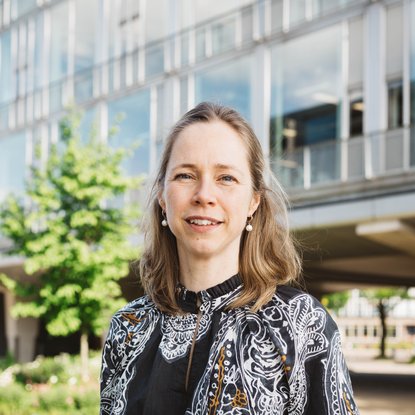Now, responsibility for meeting sustainability goals is shared evenly across all ten programs. Thanks to all the collected data and indicators within the Ideal(s) Monitor, sustainability is now a measurable part of policy and day-to-day operations within the municipality.
Data in Amsterdam: abundant and scattered
The City of Amsterdam uses vast amounts of data on a daily basis: from cameras that monitor crowd levels in the city center to sensors that detect when a trash bin is full. This information helps guide municipal actions and informs policy decisions and monitoring.
However, this abundance of information also brings certain challenges. At the City's request, researchers from the AMS Institute examined all the data the City collects and found that data is often unstructured and scattered across departments. This fragmentation leads to inconsistent definitions (for example, different departments calculate and monitor CO₂ emissions in different ways) and this results in certain data points being overlooked. For instance, there is currently little insight into how the economic development of the City affects diversity within different socioeconomic groups in neighborhoods.
The beginning: the Ideal(s) City
These findings led to the creation of the Ideal(s) City Lab: a collaboration between the City of Amsterdam and researchers from the AMS Institute, with expertise in public administration, statistics, innovation and sustainability. The lab aimed to centralize as much of the City's data as possible into one large database, allowing existing data sources, monitoring frameworks, and the City's objectives to be interconnected and analyzed.
To understand how this data aligns with Amsterdam’s ambitions and unique identity, the Ideal(s) City Lab analyzed coalition agreements from the past thirty years. This analysis distilled seven core Ideals—values that have consistently played a prominent role in Amsterdam’s policies over the last three decades. For example, Amsterdam aspires to provide equal opportunities for all residents and has a clear focus on progress and creativity.
“With this project, we aim to challenge the often-heard mantra of 'we need more data' and instead demonstrate the value, beauty, and impact that can be unlocked by intelligently connecting what already exists.”
Arnout Sabbe, Project Leader at AMS Institute

Ideals: Connecting indicators and identifying underrepresented ideals
By linking this data to the Ideals from the coalition agreements, the lab, and researchers including Fabio Tejedor, could establish new connections between different topics, objectives, and municipal departments. Indicators previously associated only with sustainability or safety are now also connected to ideals such as “equal opportunities for all.” For instance, indicators like the number of solar panels in a neighborhood or the presence of safety features such as cameras and street lighting provide insights, not only into sustainability or safety, but also into residents’ equal opportunities.
The new links between data points and indicators reveal how policy objectives relate to each other, helping identify synergies and potential overlaps for municipal projects. For instance, subsidies for solar panels in lower-income areas can contribute to the energy transition, lower energy costs, and more equitable benefits for the population. Moreover, this approach helps the municipality identify counteracting forces, such as the trade-off between increasing green spaces in the city and the need for housing development.
By classifying data sources according to these seven ideals, the lab was also able to determine which ideals are currently underrepresented in existing indicators. They found that while the City has numerous indicators around equal opportunities and sustainability, indicators for residents’ safety, health, and perceived freedom and openness lag behind, even though these are considered essential in Amsterdam’s coalition agreements.
Ideal(s) City Lab researcher Laura van der Linden engages with citizens to discuss their visions and Ideals for the City of Amsterdam.
This analysis led to the creation of the Ideal(s) City Monitor, a tool that brings together Amsterdam’s existing data sources and enables the municipality to adopt an integrated approach to monitoring. With this monitor, all municipal employees have access to the same data and can also view connections outside their own departments.
A new approach and collaboration with the City of Amsterdam
Since the start of this year, the work of the Ideal(s) City Lab has been further integrated within Amsterdam’s municipal organization, in a partnership known as the “Integrated Monitor.” Here, AMS Institute and the municipality work together to embed the previously created database as a central tool for monitoring sustainability throughout the city.
Previously, sustainability—one of the City's seven core Ideals—was largely the responsibility of the Sustainability Department. However, sustainability touches every possible branch of the municipality, from municipal sports infrastructure to poverty alleviation and from heritage preservation to harbor policy. The Integrated Monitor shows how each of the municipality's ten different programs will also have to start working toward achieving Amsterdam’s three sustainability transitions: ‘Green and Healthy,’ ‘Circular Economy,’ and ‘Energy Transition.'
“Together with the AMS Institute, we are taking an important step in showing how the municipality’s core tasks intersect with the critical challenges of our time. By connecting existing data and insights, we aim to reveal where the municipality’s actions align with the urgent sustainability transitions, moving us closer to an Amsterdam that is resilient within planetary boundaries.”
Joey Hodde, Senior Sustainability Strategist at City of Amsterdam

By embedding sustainability within the entire municipal organization, responsibility for meeting various sustainability goals is shared evenly across all ten programs, and sustainability is structurally included in the municipal budget through the Planning & Control cycle. Thanks to the collaboration between AMS Institute and the City of Amsterdam progress on all sustainability targets is now a measurable part of policy and day-to-day operations within the municipality.
Next steps
The collaboration between the Ideal(s) Monitor and the Integrated Monitor has brought several key insights to light in recent years:
- How does the City pursue its Ideals, and to what extent is it successful?
- What connections exist between different policy objectives, departments, and themes?
- How do the City's Ideals evolve over time?
- What is the social dimension of the three sustainability transitions for the municipality?
- How does sustainability become the responsibility of every city employee, rather than solely the Sustainability Department?
- How is sustainability structurally monitored, reported, and financed through data, indicators, and objectives?
In 2025, the partnership between the municipality and the AMS Institute will work toward a public-facing dashboard, making all of this data accessible and visually clear for residents and civil servants. This will also enable residents to gain insight into the data used to make decisions about the city.

